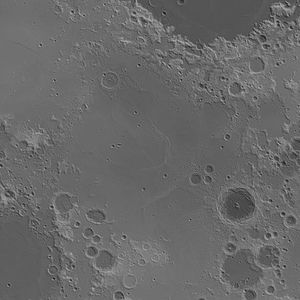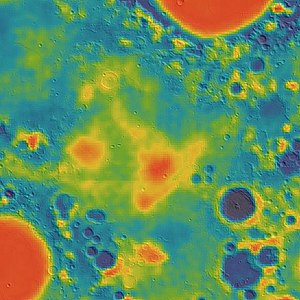Mare Fecunditatis
Coordinates 7°48′S 51°18′E / 7.8°S 51.3°E | | |
| Diameter | 840 km (520 mi)[1] | |
|---|---|---|
| Eponym | Sea of Fertility | |
Mare Fecunditatis /fɪˌkʌndɪˈteɪtɪs/ (Latin fēcunditātis, the "Sea of Fecundity" or "Sea of Fertility") is a lunar mare in the eastern half of the visible Moon. The mare has a maximum diameter of 840 km.[1]
Description
The Fecunditatis basin formed in the
Upper Imbrian epoch and is relatively thin compared to the neighboring Mare Crisium or Mare Tranquillitatis. This basin is overlapped with the Nectaris, Tranquillitatis, and Crisium basins. Fecunditatis basin meets Nectaris basin along Fecunditatis' western edge, with the area along this zone faulted by arcuated grabens. On the eastern edge of Fecunditatis is the crater Langrenus. Near the center lie the interesting craters Messier and Messier A. It was here that the first automated sample return took place via the Luna 16 probe,[2] in September 1970. Sinus Successus
lies along the eastern edge of the mare.
Unlike many other maria, there is no
GRAIL
, which unveiled an irregular pattern.
Gallery
-
Topographic map
-
Gravity map based onGRAIL
-
Apollo 15 image
See also
- Mishima Yukio, named after the sea
References
- ^ a b "Mare Fecunditatis". Gazetteer of Planetary Nomenclature. USGS Astrogeology Research Program.
- .
- S2CID 40110502.
External links
Wikimedia Commons has media related to Mare Fecunditatis.
- High resolution lunar overflight video by Seán Doran, based on LRO data, that starts over the western margin of Mare Fecunditatis and then proceeds to Mare Crisium
- Wood, Chuck (March 2, 2009). "1.50° S, 52.36 E°". Lunar Photo of the Day.



